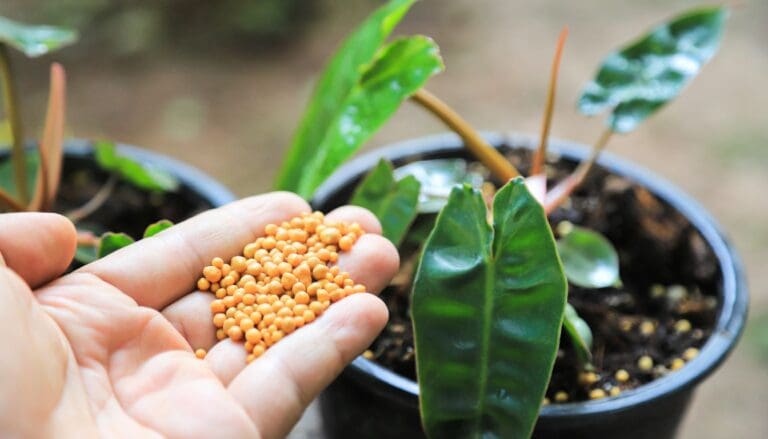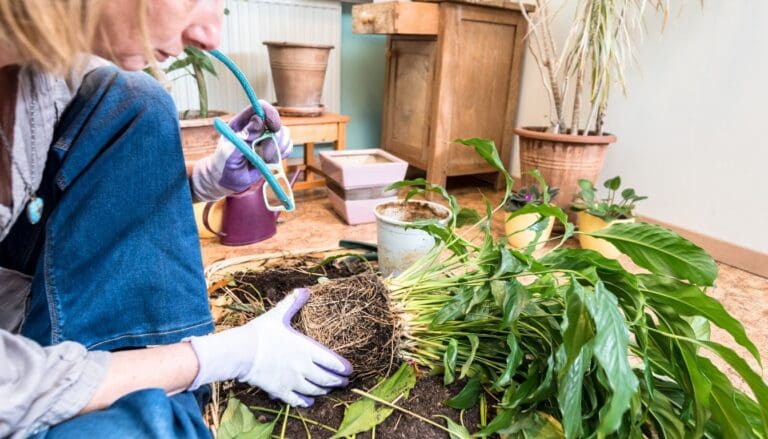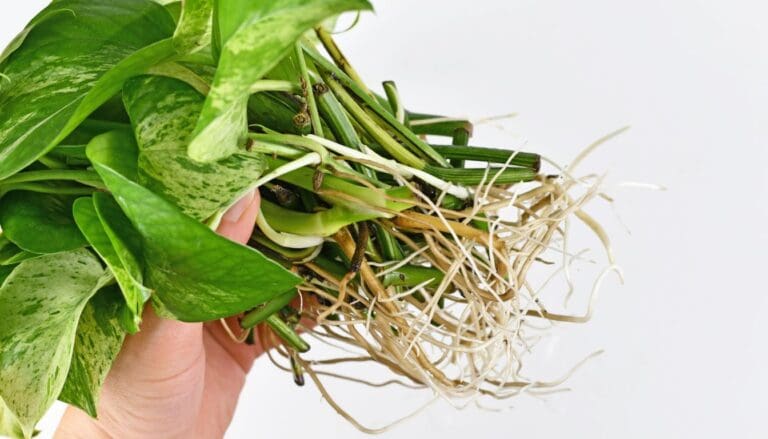Why Is My Arrowhead Plant Turning Yellow? (Problems+How To Fix)
Arrowhead plants or Syngonium are known for their striking spade-shaped foliage in the houseplant family. But if their eye-catching leaves start to turn yellow, it is a sign that indicates your plant is unhappy in its growing environment.
Overwatering is the primary cause of yellowing in arrowhead plants. Other reasons for yellow leaves can be underwatering, insufficient nutrition, pests and diseases, and natural aging. Correct the watering schedule and make sure the soil doesn’t get bone dry or soggy at any time.
If you neglect their needs or don’t provide adequate care, you may notice the yellow leaves. If you find your arrowhead turning yellow, do not panic. The rule of thumb is to find out the cause and the solution to fix the same.
This article will briefly discuss why your arrowhead plant leaves turn yellow and what strategies you can look for to cure the condition.

Please note: Simplify Plants is reader-supported. Some links in the post are affiliate links and I get a commission from purchases made through links in the post.
What causes my arrowhead plant to turn yellow?
There can be numerous reasons that might cause your arrowhead plant to turn yellow, such as:
- Overwatering
- Underwatering
- Wrong lighting
- Temperature fluctuations
- Low humidity
- Insufficient nutrition
- Pest and diseases
- Natural Aging
Lets us discuss all the above points in detail.
Overwatering

Overwatering is the most common cause for your plant to turn yellow.
If you find that the leaves are not dry and crispy but are yellow and falling off, it means you are overwatering the plant.
Arrowhead plants should get watered when the topsoil in the pot is dry.
They will slightly wilt when they need water but will not respond well if they sit on standing water.
Soggy soil and waterlogged conditions will reduce the oxygen level in the soil, due to which the roots will suffocate and become weak.
Such roots will not absorb nutrients, minerals, and water from the soil needed for healthy plant growth.
The excess moisture will cause their roots to rot, and if you continue to overwater, they will eventually die.
Yellow leaves are one of the first indicators of root rot disease.
If overwatering is the cause behind yellow leaves, you need to stop watering your plant for a few days and keep them in a bright location until the soil dries up.
If the Syngonium is experiencing root rot, you need to consider repotting it by discarding all the damaged roots and parts of the plant.
Before watering, you should always check the soil moisture by inserting your finger or using a moisture meter.
Maintaining proper and consistent soil moisture is important for the well-being of your arrowhead plant.
Also read: How To Water Arrowhead Plant? (How Often+Summer & Winter)
Underwatering

The arrowhead plant might also get yellow leaves if they do not get the water needed for survival.
The yellow leaves will feel dry and crispy if you don’t water them for a while.
If you continue underwatering, the plant will start to dehydrate, and the leaves will turn yellow and become limp.
If the yellow leaves are caused due to underwatering, you should reintroduce watering slowly.
Many of us may think that the best way to overcome underwatering stress is by drowning the plant in water, but this can put your plant in shock and harm more.
Instead, you can overcome this problem by watering a little regularly for a few days to ensure that the soil is well soaked.
You must keep a few things in mind when fixing your underwatered Syngonium.
- Firstly check the moisture level of the topsoil.
- If the soil feels damp, avoid watering for a few days.
- Water your arrowhead plant when the soil is about 50-75% dry.
- Always plant your arrowhead plant in a soil mix that is well aerated and retains the required moisture.
Wrong lighting

Arrowheads are spectacular houseplant that is quite versatile with their lighting needs.
They can adjust themselves to contrasting light conditions for a certain period.
Although arrowheads will grow best when they receive bright to moderate indirect sunlight, they grow well in the indoor environment, and exposing them to direct sunlight can cause sunburn leading to yellow leaves.
If too much light is the problem behind yellow leaves, you should immediately place your plant in a shadier spot.
Also, prune off the burned leaves so that the place can focus on new and healthy growth.
Some arrowhead species can tolerate low light conditions, but their growth will slow down.
If you continue to place them in very low light spots, they may even develop yellow patches on the leaves, which are irreversible.
Even if they receive all the ideal conditions, their growth will stunt without proper light.
If you think that your Syngonium is turning yellow due to insufficient light, consider changing the plant’s position.
The best place for them would be 5-6 feet away from a window that gets bright indirect light.
Also read: Arrowhead Plant Light Needs: What Type, How Much & More
Temperature fluctuations
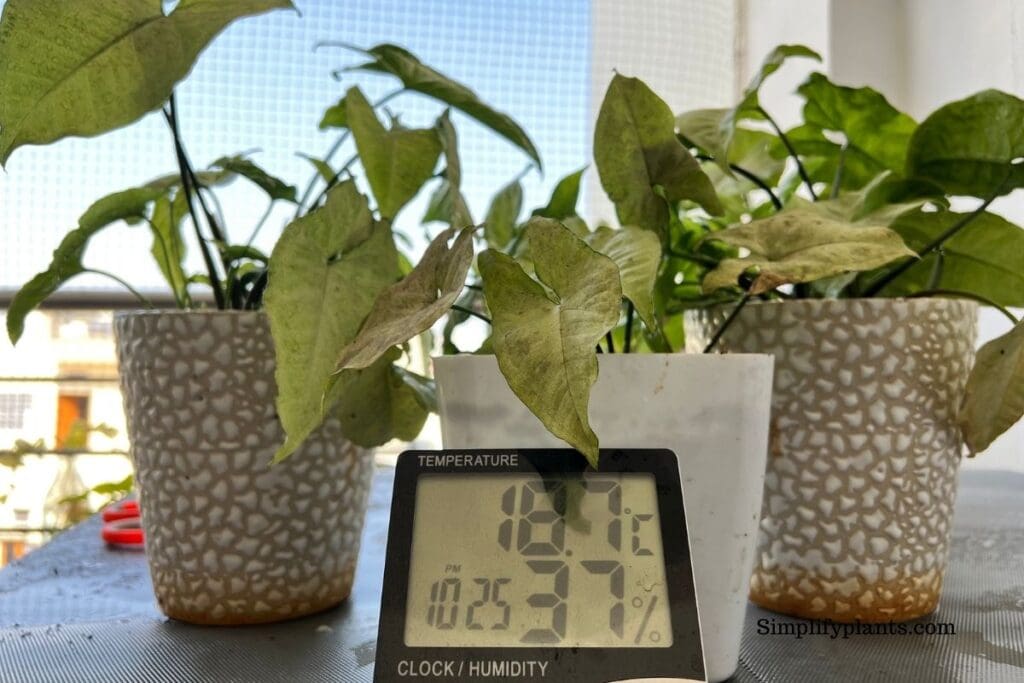
Arrowheads plants come from tropical and subtropical environments and enjoy warm conditions.
They are sensitive to temperatures below 50°F (10°C).
Such lower temperatures can stress the plant and cause yellow leaves.
On the other hand, high temperatures can also cause sunburn and yellow leaves.
The ideal temperatures for growing arrowhead plants will range between 60-85°F.
Sometimes a sudden temperature fluctuation can ruin the striking green color of your plant and cause yellowing.
To check the temperature around your Syngonium, you can use a digital thermometer.
Make sure to keep your arrowhead away from any heating source to avoid burning the foliage.
Also, avoid keeping them near a window sill in winters as the low temperatures and frost can stress the plant, causing yellow leaves.
Also read:Can Arrowhead Plants Grow Outside? (Outdoor Care+Bringing Them In)
Low humidity
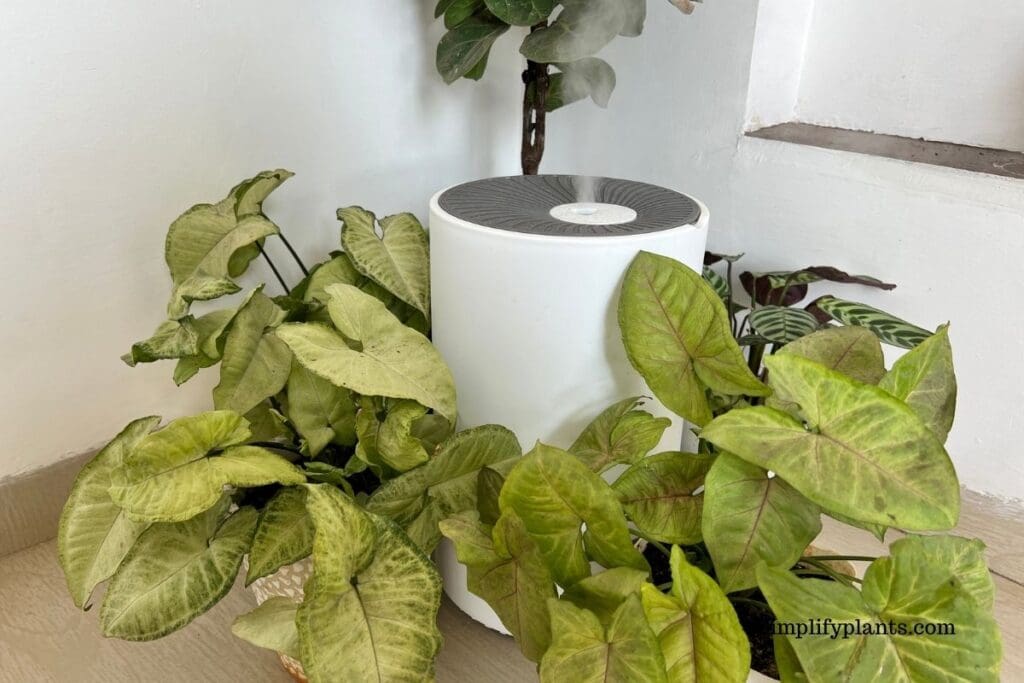
Arrowhead plants prefer high humidity, similar to their native Central and South American regions.
Humidity levels not below 50% will help them grow properly, preventing many leaf problems.
Low humidity will cause the leaves of your arrowhead plant to get brown tips and edges.
If you continue to grow them in low humid conditions, their leaves will droop and turn yellow on both sides and have brown spots.
Also, during the winter months, the drops in the humidity levels can certainly affect your Syngonium.
- You can increase the humidity levels for the arrowhead plant by misting their leaves twice or thrice a week. However, it is not a long-term solution as this increases the humidity only for a short period.
- You can create a humid environment around your arrowhead plant by placing the plant on a tray or container filled with pebbles and water. The water from the tray will evaporate, creating a humid environment around your Syngonium.
- You can get a humidifier to increase the humidity level around your arrowhead plant.
- You can keep it with other humidity-loving houseplants to raise the moisture level. Through transpiration, the plants will add humidity to the environment.
- Also, keep in mind not to place your plant in a region with dry air, especially near a heating device or vents.
Also read: Do Arrowhead Plants Like Humidity? (+Misting?)
Insufficient nutrition

Arrowhead plants are considered moderate feeders.
These plants can produce the most stunning foliage with good care and proper fertilization.
Yellow leaves are a sign that your plant is not getting sufficient nutrition.
The essential nutrients needed for plant growth are Nitrogen, Magnesium, and Phosphorous.
Lack of these nutrients will weaken the plant and cause yellow leaves.
The ideal time to fertilize your plant is their growing months, i.e., spring and summer.
You should stop fertilizing during the fall and winter seasons as it is their dormant season when they stop growing.
Overfertilization can also cause yellow leaves.
Excess application of fertilizers will lead to toxic salt build-up.
The salts take up the moisture from the soil and inhibit the plant’s growth causing yellow leaves.
If you have overfertilized your plant, you can flush the soil with distilled water.
You can repot the plant in another container and add a fresh potting mix for their speedy recovery.
The best fertilizer for the arrowhead plant will be an all-purpose houseplant fertilizer.
Dilute the fertilizer to half strength and apply it every four weeks after watering it.
You can also use slow-release granules during spring, but follow the packaging details and instructions before application.
Also read: How Often Should You Fertilize Arrowhead Plant? (Best Fertilizer For Arrowhead)
Pest and diseases

If your arrowhead plant is weak and or stressed, they become easy targets for pests.
The common pests that can attack your plant include spider mites, mealybugs, and scales.
Spider mites are sap-sucking insects that suck out the nutrients and moisture from the arrowhead leaves.
They have a piercing mouth that can stunt your plant’s growth and cause many leaf problems, including yellow leaves.
These bugs affect arrowhead that is grown indoors, and most are the result of low humidity issues.
Pests are difficult to treat, and if your plant has these bugs, you need to take immediate action to restore its health.
- First of all, if you have a pest-infested plant, immediately isolate the plant in one place so that the pests do not get spread to other plants.
- Then inspect the type of pest that has infested the plant.
- If the bugs are visible, you can handpick them.
- You can also keep your Syngonium under running water to wash off these pests.
- You can use alcohol-based insecticidal sprays and apply them all over your plant. Before application, read the product direction and frequency to be used.
- You can apply neem oil solution on your arrowhead plant to keep the pests away. For this, you need to spray the neem solution all over the plant for two consecutive weeks until the pests go away.
Also read: Bugs On Arrowhead Plant: Common Pests+How To Get Rid Of Them
Natural aging

If you find plenty of new growth in your arrowhead plant while the leaves at the bottom turn yellow, then that yellowing is natural.
With time the old foliage of the plant will turn yellow and fall off as the plant tries to get rid of them.
Before falling off, the leaves will turn yellow.
They will shed their old leaves, and the plant will use the energy and nutrients for new growth.
Yellowing of leaves due to aging is natural to all types of plants, and it is not something to worry about.
However, all the leaves start turning yellow or if the leaves shed too fast, try to investigate the problem and fix it before it’s too late.
How to prevent yellow leaves on your arrowhead plant?
The only way to prevent yellow leaves on your arrowhead plant is by providing them with the ideal growing conditions and proper care.
Here are some points you should keep in mind for growing a healthy arrowhead plant.
- Provide your arrowhead plant with bright indirect sunlight and keep them away from direct sunlight. You can also use artificial light to fulfill your plant’s lighting requirements.
- Water your Sungonium only when 50-75% of the soil is dry. Do not water if the soil feels moist and wait for it dry. Reduce watering during winters to prevent overwatering.
- Grow your plant in well-drained, fertile soil and use a pot with a good number of drainage holes to avoid overwatering.
- Fertilize your arrowhead plant with an all-purpose household fertilizer by diluting it to half strength during the growing season. Avoid fertilizing the plant during winter as it is the dormant season.
- Maintain a minimum humidity level of 50% for your plant. Use a humidifier or group your plant with other moisture-loving plants to raise the humidity in the surrounding.
- Keep your arrowhead plant away from cold drafts, frost, air conditioners, coolers, and low temperatures. Also, do not keep the plant near any heating device, vents, heaters, etc.
- Apply a neem oil solution to your plant every month to keep pests and diseases away.
- Repot your plant once every 2-5 years when they get rootbound. For repotting, use a slightly bigger pot than the old one.
- Rotate your arrowhead plant every few days so that the leaves on all the sides of the pot will get a good amount of sunlight.
- Clean the leaves after every few days to keep them dust-free and encourage proper photosynthesis.
Should I prune the yellow leaves from my Arrowhead plant?

You can prune the yellow leaves of your arrowhead plant as these leaves are of no use to the plant, and pruning them off will make space for the new growth.
Most of the time, the old yellow leaves fall from the plant themselves.
You should prefer pruning them during the growing season as the plant is actively growing to recover from stress.
For pruning your plant, use pruning tool blades and trim off the leaf right above the node.
Clean the pruning tools before using them by wiping them off with rubbing alcohol.
Pruning will help remove the yellow leaves and make the plant look even and encourage new growth.
Reference: CABI, Britannica, United States Department of Agriculture, Wikipedia, Children’s Health Queensland Hospital and Health Service, Missouri Botanical Garden.
Recommended Garden Supplies
| Product Image | Our Recommended Gardening Supplies | Check Offers! |
|---|---|---|
Top Top
Top
Top
Top
Top
Top
Top
Top | rePotme Houseplant and Tropical Classic Potting Soil Mix | Check Offer On Amazon |
 Top
Top
Top
Top
Top
Top
Top
Top | Espoma Organic Indoor Plant Food | Check Offer On Amazon |
 Top
Top
Top
Top
Top
Top
Top
Top | GooingTop LED Grow Light 6000K Full Spectrum Clip Plant Growing Lamp | Check Offer On Amazon |
 Top
Top
Top
Top
Top
Top
Top
Top | Soil Moisture Meter | Check Offer On Amazon |
 Top
Top
Top
Top
Top
Top
Top
Top | Govee Hygrometer Thermometer, Bluetooth Enabled! | Check Offer On Amazon |
 Top
Top | LEVOIT Humidifiers for Large Room(Best For Plants) | Check Offer On Amazon |
 Top
Top
Top
Top
Top
Top
Top
Top | Upgraded DIY Automatic Drip Irrigation Kit, 15 Potted Houseplants Support | Check Offer On Amazon |
 Top
Top
Top
Top
Top
Top
Top
Top | Stainless Steel Heavy Duty Gardening Tool Set | Check Offer On Amazon |
 Top
Top
Top
Top
Top
Top
Top
Top | Bonide Insecticidal Soap | Check Offer On Amazon |
 Top
Top
Top
Top
Top
Top
Top
Top | Bonide 32 oz Spray Neem Oil for Organic Gardening | Check Offer On Amazon |
 Top
Top
Top
Top
Top
Top
Top
Top | Garden Safe Fungicide | Check Offer On Amazon |



